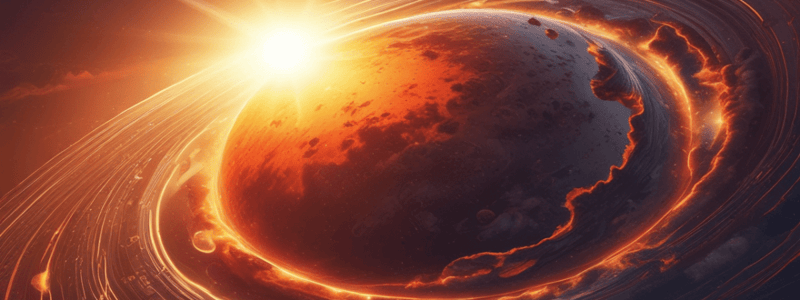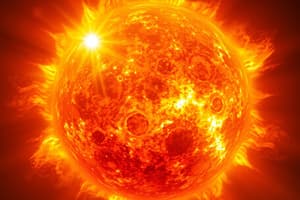Podcast
Questions and Answers
What does the word 'photo' mean?
What does the word 'photo' mean?
- Light (correct)
- Sun
- Energy
- Color
What is the surface layer of the sun that we can see with our eyes called?
What is the surface layer of the sun that we can see with our eyes called?
- Photosphere (correct)
- Corona
- Chromosphere
- Monochromator
Why are sunspots darker than the rest of the sun's surface?
Why are sunspots darker than the rest of the sun's surface?
- They are farther away from the sun's core
- They are much cooler than the surrounding gases (correct)
- They are made of a different material
- They are hotter than the surrounding gases
When is the corona of the sun visible?
When is the corona of the sun visible?
Which constellation is the Big Dipper a part of?
Which constellation is the Big Dipper a part of?
Which star is found in the constellation Leo?
Which star is found in the constellation Leo?
What is the name of the constellation that can be found by continuing the curved line of the Big Dipper's handle?
What is the name of the constellation that can be found by continuing the curved line of the Big Dipper's handle?
Which constellation is visible between December and May and resembles two brothers holding hands?
Which constellation is visible between December and May and resembles two brothers holding hands?
How can you locate the constellation Gemini using the Big Dipper?
How can you locate the constellation Gemini using the Big Dipper?
Which constellation is mentioned in the Bible?
Which constellation is mentioned in the Bible?
What are the names of the two supergiant stars in the constellation Orion?
What are the names of the two supergiant stars in the constellation Orion?
In which constellation is the star Sirius located?
In which constellation is the star Sirius located?
Flashcards are hidden until you start studying
Study Notes
Sun
- The sun gives food to all living things and is a source of energy.
- The innermost section of the sun is called the core.
- The surface layer of the sun that we see with our eyes is called the photosphere, meaning "sphere of light".
- Sunspots are dark spots on the sun's surface that are cooler than the surrounding gases.
- The photosphere is dangerous to look at directly.
Chromosphere and Corona
- The chromosphere is the fiery atmosphere of the sun that displays giant bursts of gas.
- We view the chromosphere using a monochromator, or "one-color meter".
- The corona is the vapor blanket surrounding the sun, visible only during a total solar eclipse.
Constellations
- Constellations are star groups that resemble people, animals, and objects.
- The Big Dipper is a star group used as a starting point for locating constellations and is part of the Great Bear/Ursa Major constellation.
- The two stars in the Big Dipper's bowl farthest from the handle are called the pointers.
- Polaris is the North Star, located in the Little Dipper.
Locating Constellations
- The Big Dipper, Little Dipper, and Polaris can be seen all year round.
- Leo the Lion constellation is just below Ursa Major and can be seen in February-June.
- We can find Regulus by drawing a straight line down from the two stars in the Big Dipper's bowl closest to the handle.
- The Herdsman constellation is found in the summer sky just under Ursa Major's nose, and Arcturus is its largest star.
- We can find the Herdsman by continuing the curved line of the Big Dipper's handle to the star Arcturus.
- The Twins (Gemini) constellation is visible between December and May, and can be located by drawing an imaginary diagonal line that passes through the Big Dipper's bowl and then continues outward from the bottom right corner.
- Orion is the most impressive constellation, looking like a mighty hunter, and is mentioned in the Bible.
- The two supergiant stars in the constellation Orion are Betelgeuse and Rigel.
- The star Sirius is located in the Big Dog (Canis Major) constellation.
- The Scorpion constellation looks like a dreaded arachnid and weaves through the Southern sky, with Antares as its most outstanding star.
Studying That Suits You
Use AI to generate personalized quizzes and flashcards to suit your learning preferences.




